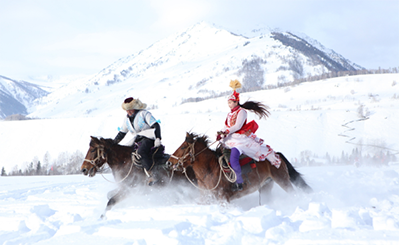Street dancers set a hot pace
![1691041647887086017.jpg E Yafei, a member of the Xibe ethnic group, discovered street dance in his teens through videos.[Photo provided to China Daily].jpg](http://subsites.chinadaily.com.cn/xinjiang/att/20230803/1691041647887086017.jpg)
E Yafei, a member of the Xibe ethnic group, discovered street dance in his teens through videos.
When Bahtiyar Yusanjan, a young man from Urumqi, the capital of Xinjiang Uygur autonomous region, attended a friend's wedding last month, he experienced far more than delicious food, phenomenal dancing and nonstop music.
After the traditional ceremony, people started to dance and sing while playing local instruments commonly seen at weddings. However, when a group of young men took to the stage, the party reached a climax.
The group formed a circle, with one man flipping from his back onto his chest, kicking high in the air. The others responded to his dazzling dance moves by applauding and cheering, before taking to the floor themselves.
"I joined the group and more people were quick to follow suit. The wedding was transformed into a street dance party. We danced for hours and everybody was very happy," said Bahtiyar Yusanjan, 35.
The bridegroom and many of the guests at the wedding are street dancers, including Bahtiyar Yusanjan, who was inspired by the improvised performance to choreograph an original dance piece titled A Happy and New Era. The work premiered at a street dance performance on July 21 during the 6th China Xinjiang International Folk Dance Festival, which is scheduled to end in Urumqi on Saturday.
The piece featured 12 dancers ranging in age from 17 to 28 from the street dance studio DSP (dream, soul and passion), where Bahtiyar Yusanjan works.
The piece received warm feedback from the audience thanks to its creative choreography, which mixed street dance moves with traditional Xinjiang ethnic dance steps. Traditional plucked instruments such as the dutar, sattar, rawap and gijja were used for the work.
The performance also featured competitions that attracted nearly 300 dancers from ethnic groups, including the Han, Hui, Tajik, Uygur and Daur. A Happy and New Era won the Best Dance Piece award.
![1691041699258014529.jpg A girl dances at a festival in Urumqi.[Photo by Zou Hong China Daily].jpg](http://subsites.chinadaily.com.cn/xinjiang/att/20230803/1691041699258014529.jpg)
A girl dances at a festival in Urumqi.[Photo by Zou Hong/China Daily]
"I finished the piece, which was inspired by the wedding party, just a few days before the competition, as I wanted to show the contemporary lives of young people in Xinjiang," Bahtiyar Yusanjan said. He added that it is natural to combine street dance with cultural elements from the region, such as folk music and musical instruments.
"Traditional music and dancing are in our blood because we grew up with them. They are essential parts of our daily lives, but we are open to contemporary culture, so street dance really helps diversify our artistic creation," he added.
The 6th China Xinjiang International Folk Dance Festival featured 28 dance productions with some 60 performances, including ballet, folk dance, dance galas and dramas.
The theme of the festival, which was first held in 2008, was "Dancing Dreams and Harmonious Silk Road", signifying the beauty of Xinjiang, which has witnessed numerous cultural exchanges between East and West due to its location along the Silk Road.
Street dance, or hip-hop dance, which originated in the United States in the late 1970s, featured at the festival for the first time, showcasing a variety of moves, including breaking, locking and popping.
Feng Shuangbai, president of the Chinese Dancers Association, said: "A vibrant and fast-developing street dancing scene is developing in China. Xinjiang is no exception, and is even leading the way thanks to its diverse culture, which was why street dance was included in the festival for the first time.
"Like any contemporary art form, street dancing uses art as a platform for our voices to be heard. With their creative choreography and rich artistic resources such as folk dance and music, street dancers in Xinjiang are pushing the art form to new levels and are constantly evolving."
![1691041718559025387.jpg A dancer performs during the 6th China Xinjiang International Folk Dance Festival, which is scheduled to end in Urumqi on Saturday.[Photo by Zou Hong China Daily].jpg](http://subsites.chinadaily.com.cn/xinjiang/att/20230803/1691041718559025387.jpg)
A dancer performs during the 6th China Xinjiang International Folk Dance Festival, which is scheduled to end in Urumqi on Saturday.[Photo by Zou Hong/China Daily]
Popularity rises
Xia Rui, deputy director and secretary-general of the China Hip-Hop Union Committee, which was founded by the China Dancers Association in 2013, said, "There has been recognition of the rising street dance scene in Xinjiang over the past decade, which we are very proud about."
In recent years, street dance has enjoyed widespread popularity among young Chinese, Xia added.
The art form has taken root in China for a number of reasons, including internet exposure, high-profile celebrity collaborations and televised competitions.
In 2019, organizers of the 2024 Olympic Games in Paris proposed adding the hip-hop style of break dancing as an Olympic event. The idea was given a trial run at the 2018 Youth Games in Buenos Aires, capital of Argentina, and in 2020, break dancing was approved as a sport for the 2024 Olympics.
Numerous street dance competitions have been held in China, bringing talented dancers into the limelight and allowing the art form to be accepted by the mainstream.
The China Hip-Hop Union Committee said more than 8,000 street dance studios are registered in the nation.
Bahtiyar Yusanjan said that in Xinjiang alone there are over 1,000 registered street dance teachers. Born and raised in Urumqi, he was introduced to the art form by his elder sister.
"I loved dancing as a child. My parents told me that I danced when I listened to music, either on television or radio. Since I was introduced to the art form, I have danced each day by imitating the moves I saw on my sister's DVDs," he said.
He specializes in performing locking — a combination of fast movements and remaining in improvised positions for a short time.
Bahtiyar Yusanjan never planned to become a full-time street dance performer until he enrolled to study at Xinjiang Normal University in 2011. The institution began degree studies in the art form the previous year.
He joined DSP in 2006, and now heads the studio, which was launched in 2001 and is one of the oldest of its kind in Xinjiang.
![1691041755827007821.jpg A performer draws inspiration from Xinjiang folk dance movements.[Photo by Zou Hong China Daily].jpg](http://subsites.chinadaily.com.cn/xinjiang/att/20230803/1691041755827007821.jpg)
A performer draws inspiration from Xinjiang folk dance movements.[Photo by Zou Hong/China Daily]
"Some 90 percent of street dance teachers in Xinjiang have trained at DSP, and we now have three branch studios in the region," he added.
DSP was launched by Furkat Bahader, a Uygur born and raised in Urumqi who joined the street dance session at the 6th China Xinjiang International Folk Dance Festival as a curator.
"When DSP opened 22 years ago, we only had a few students, because street dance was not that popular and many people didn't know what it was about," said Furkat Bahader, who is in his 40s and has been devoted to promoting and popularizing the art form in Xinjiang by bringing major street dance competitions to the region.
"Things have since changed. Many young parents who enjoy street dance are sending their children to learn it when they are just 3 or 4 years old," he said. "In Xinjiang, dancing is commonly seen on the streets, in shopping malls and at family parties. The aim of this art form and any other type of dance is the same — to express yourself and way of life."
Furkat Bahader's love of street dance started from the day his father, who studied in Japan in the 1990s and is a professor of mathematics at Xinjiang University, showed him a video of Japanese street dancers.
After graduating from the law school at Xinjiang University and working as a lawyer, Furkat Bahader decided to quit his job. He pursued his dream of becoming a street dance performer by traveling to Shanghai and Shenzhen, Guangdong province, to learn the art form from professionals.
"One day, I went to a party where there were many street dancers. Even before I entered the room, I was overwhelmed by the loud music and hip-hop beat. I moved to the rhythm, and everything I saw, such as the dancers, the disc jockeys and even my reflection in a mirror, seemed like scenes from a slow-motion movie. For someone like myself, a young guy from remote Xinjiang, it was amazing," he said.
E Yafei, 35, a member of the Xibe ethnic group, stood out among the festival competitors and was one of the top four winners of the 2v2 open-style competition. Many of his moves were impromptu, ranging from impressions of everyday life to his interpretation of Xinjiang folk dance movements.
He has been dancing for 14 years and also teaches street dance.
"I am inspired by street dance for many reasons. It gives me confidence and allows me to express myself," said E Yafei, who discovered the art form in his teens through videos, and found it "cool and fun". Although his parents considered the profession to be the preserve of outgoing young people, he insisted on pursuing it.
Although there was no guarantee of financial success, he founded his own street dance studio in 2017.
"When I started dancing, I spent eight to nine hours a day perfecting my skills. I remember dancing all day and not eating for about two days. My parents were astonished by my intense energy and passion," he said. "I loved dancing on the streets with my friends. The loud music attracted attention, and the more people stopped and looked at us, the more excited we became and the harder we danced."
As a teacher, he also enjoys taking his students to dance on the streets.
"They are very happy to be seen dancing on the streets, as it's a way of expressing confidence in themselves. I am glad that many parents consider street dance as a kind of sport and that they are also fans of the art form," E Yafei said.
Kudirat, 32, a member of the judging panel for the festival's street dance competitions, has worked at similar events in Xinjiang since 2014. He also owns a street dance studio in the region, which opened in 2016.The studio has trained more than 4,000 students in the art form.
"Street dance is from the West. We started by learning and imitating dance moves from Western artists, but we now have our own creative works," he said.
"I was impressed by the competitors this year. From the 2v2 open-style competition to group dance works, cultural elements from Xinjiang were featured in their performances at a very high level. It was very hard to decide on scores," he added.
Born and raised in Ili Kazak autonomous prefecture, Xinjiang, Kudirat gained an introduction to street dance by watching the music videos of Michael Jackson. His parents were against the idea of him learning and practicing the dance moves because they feared he was wasting his time.
To find a stable job, Kudirat studied finance before graduating from Hubei Minzu University. After working for a State-owned company for two years, he decided to quit his job and become an entrepreneur.
"I had about 20,000 yuan ($2,800), so I returned home to open my street dance studio, named Circular. I could only afford a low rent, so the studio was located out of town. In 2016, I had just three students," he said.
Circular now has three branch studios in Ili, with 17 teachers instructing some 1,000 children with an average age of 8.
"Xinjiang is uniquely positioned to build up a large street dance fan base, because dancing is our tradition. It's the same for many Chinese ethnic groups," Kudirat said.
 Attractions
Attractions Dining
Dining Culture
Culture